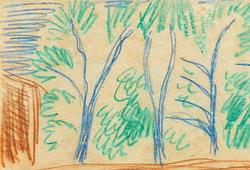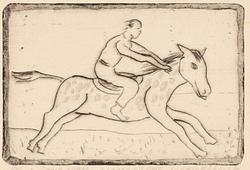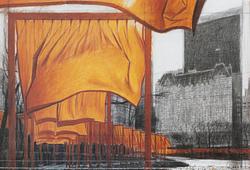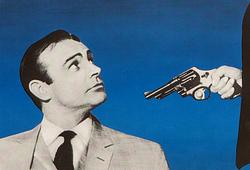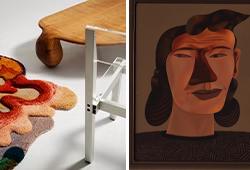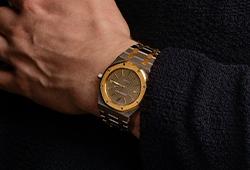Gunnar Asplund
a ceiling lamp model "6022", Arvid Böhlmarks Lampfabrik, 1920-50s.
Lacquered metal. polished 'veluria' glass, height ca 110 cm, diameter ca 50 cm.
Wear, minor chips, one decorative detail missing. Function not guaranteed.
Alkuperä - Provenienssi
Arvid Böhlmarks Lampfabrik
Kirjallisuus
Arvid Böhlmark's lamp factory, catalog 1922-1936. 1953-63.
During the period 1922-1936, the lamp is depicted in the catalogue with the polished 'veluria' glass, as well as with the original suspension device, without a ceiling cup.
During the period 1953-1963, the catalogue shows the lamp in frosted glass and the later ceiling cup.
During the period 1936-53 when the lamp is not in the catalogue, it may have been produced in versions.
In an ad from 1949, it says that the lamp did not sell very well during the 1920s but now(1949) the lamp is a popular product. Maybe they had old stock veluria glass shades that from the 1920 that was sold during the 1940-50s.
Muut tiedot
This is the oldest lamp from Scandinavia that still is in serial production. The model was designed for Gunnar Asplund's music room at the 'Workshop's' exhibition in 1920 at Liljevalch's art gallery in Stockholm. Series produced by Böhlmarks from 1922 onwards. From 1965, the lamp is manufactured by Ateljé Lyktan with a simpler design of the "details" and a matt lacquer on the metal.
Bukowskis is proud to present a curated collection of lighting fixtures from Arvid Böhlmarks lamp factory. The selection mainly focuses on the company’s production during the 1940s and 50s and the Swedish modern era with undulating shapes and organic materials.
During the first half of the 20th century, Böhlmarks was one of Scandinavia’s leading companies in the design and production of light fixtures. Alongside Nordiska Kompaniet in Nyköping, Ateljé Lyktan in Åhus and Bröderna Malmströms in Malmö, Böhlmarks in Stockholm was one of the industry’s most important players.
The company was founded in 1872 by Daniel Arvid Böhlmark. During the first years, the focus was on importing and sales of various kerosene and oil lamps as well as accessories. The company grew rapidly and the production of its own light fixtures took off. In order to meet the demand for new types of electric light fixtures with glass lamp shades of different qualities and techniques, the Pukeberg glass factory was acquired in 1894. This became an important event in the company’s development as it opened up opportunities for greater influence of self-designed luminaires. After the company acquired new premises for glass production in 1913, Pukeberg became one of Sweden’s largest glass manufacturers. Böhlmarks was now a market-leading company in the production of light fixtures and household glass with showrooms at two central addresses in Stockholm, Norrmalmstorg and Högbergsgatan 19-25, which was also the address for the light fixture factory. In its heyday, the company had over 400 employees. Between the 1920s and 1950s, Böhlmarks was a significant player in the Swedish design movement. It was an era that we today regard as a golden age for Swedish design and craftsmanship. During these decades, some of the country’s most significant luminaires were designed and produced at Böhlmarks. During the 1960s, however, demand wained. In connection with the closure of the factory in Stockholm in 1964, production was moved to Pukeberg. In 1965 Böhlmarks was bought by Ateljé Lyktan and several models are launched after that under their brand, including Gunnar Asplund’s classic lamp”6022”.
The first decades of the 20th century were characterized by an ambition to link artists to industry. Böhlmarks also followed the prevailing ideal and employed Elis Bergh as Artistic Director in the years 1906-1916. Elis Bergh, however, later came to make a bigger mark in design history after he left Böhlmarks and instead joined Kosta glasbruk. When then-architect Harald Notini came to Böhlmarks in 1916, he was hired as Artistic Director both for the Stockholm factory and for the glass production at Pukeberg. The new Artistic Director Notini led Böhlmarks in a modern, innovative direction that characterized above all the company’s range of new, contemporary light fixtures and glass. A large part of Böhlmark’s catalogs during the first half of the 20th century consisted of traditional chandeliers and other fixtures in older style imitations. Notini’s strength lay in pushing the company’s designers forward and producing what were considered at the time to be ground-breaking and distinctive designs. His personal expression spans between the most elegant Swedish Grace during the 1920s, strictly functionalist luminaires that were presented at the Stockholm exhibition in 1930, to the Swedish Modern aesthetic, which is highly appreciated today with luminaires in above all brass with details in glass, wood and leather from the 1940s and 50s.
Harald Elof Notini (1879-1959) was the son of the sculptor Axel Notini and received his artistic heritage from his father. He was trained as a sculptor and interior architect and studied in his younger years at Högre konstindustriella skolan, today known as Konstfack. Notini, who was active at Böhlmarks throughout his career, came to play a significant role in lighting design in Sweden during the first half of the 20th century. In the family’s genealogy, it can be read - “Harald became faithful to his company for the rest of his life” and that he still had his office and a lot of work duties until the age of 79 (1958). In a commemorative publication for Böhlmark’s 75th anniversary published in 1947, it is noted that Notini was active as an Artistic Director and continued to play a significant role in the design of lighting fixtures and household glass. Considering Böhlmarks’ extensive product catalogs, Notini must have had a designers office with several employed designers. A designer who probably had a great influence on the company’s design is Uno Westerberg, who was employed by Böhlmarks in 1935 as a designer of lighting glass. One of Westerberg and Notini’s luminaires is today represented at MoMA in New York. Westerberg took over as Artistic Director of Pukeberg after Böhlmarks closed down.
There were several named architects and designers who designed luminaires that Böhlmarks came to produce and also put into series production. An important person in this context is architect Gunnar Asplund, who designed a number of luminaires for Böhlmarks, including the iconic hemispherical Swedish Grace luminaire “6022”, which was shown at Verkstaden’s exhibition in 1920, as well as luminaires for the Town Hall in Gothenburg. The sculptor Alice Nordin, who created expressive Art Nouveau fixtures around the turn of the century in 1900, has also been of great importance to Böhlmarks.




